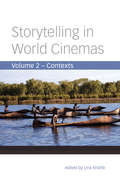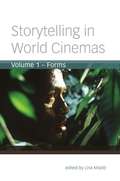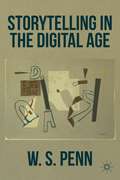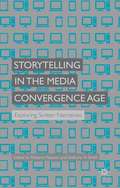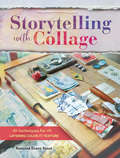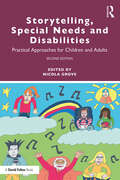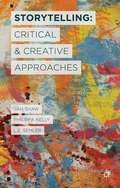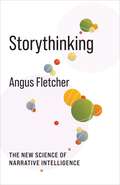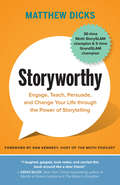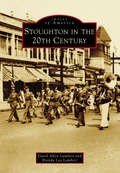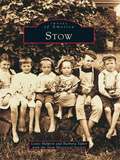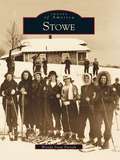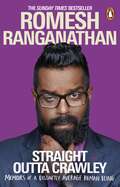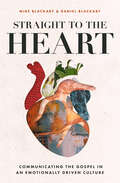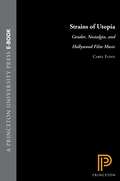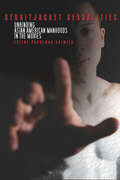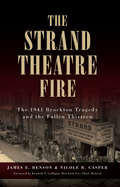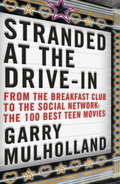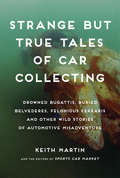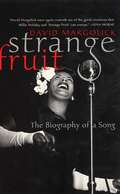- Table View
- List View
Storytelling in World Cinemas
by Lina KhatibStorytelling in World Cinemas, Vol. 2: Contexts addresses the questions of what and why particular stories are told in films around the world, both in terms of the forms of storytelling used, and of the political, religious, historical, and social contexts informing cinematic storytelling. Drawing on films from all five continents, the book approaches storytelling from a cultural/historical multidisciplinary perspective, focusing on the influence of cultural politics, postcolonialism, women's social and cultural positions, and religious contexts on film stories. Like its sister volume, Storytelling in World Cinemas, Vol. 1: Forms, this book is an innovative addition to the academic study of world cinemas.
Storytelling in World Cinemas
by Lina KhatibStorytelling in World Cinemas, Vol. 2: Contexts addresses the questions of what and why particular stories are told in films around the world, both in terms of the forms of storytelling used, and of the political, religious, historical, and social contexts informing cinematic storytelling. Drawing on films from all five continents, the book approaches storytelling from a cultural/historical multidisciplinary perspective, focusing on the influence of cultural politics, postcolonialism, women's social and cultural positions, and religious contexts on film stories. Like its sister volume, Storytelling in World Cinemas, Vol. 1: Forms, this book is an innovative addition to the academic study of world cinemas.
Storytelling in World Cinemas: Contexts
by Lina KhatibStorytelling in World Cinemas, Vol. 2: Contexts addresses the questions of what and why particular stories are told in films around the world, both in terms of the forms of storytelling used, and of the political, religious, historical, and social contexts informing cinematic storytelling. Drawing on films from all five continents, the book approaches storytelling from a cultural/historical multidisciplinary perspective, focusing on the influence of cultural politics, postcolonialism, women's social and cultural positions, and religious contexts on film stories. Like its sister volume, Storytelling in World Cinemas, Vol. 1: Forms, this book is an innovative addition to the academic study of world cinemas.
Storytelling in World Cinemas: Forms
by Ed. Khatib LinaStorytelling in World Cinemas, Vol. 1: Forms is an innovative collection of essays that discuss how different cinemas of the world tell stories. The book locates European, Asian, African, and Latin American films within their wider cultural and artistic frameworks, showing how storytelling forms in cinema are infused with influences from other artistic, literary, and oral traditions. This volume also reconsiders cinematic storytelling in general, highlighting the hybridity of 'national' forms of storytelling, calling for a rethinking of African cinematic storytelling that goes beyond oral traditions, and addressing films characterised by 'non-narration'. This study is the first in a two-volume project, with the second focusing on the contexts of cinematic storytelling.
Storytelling in World Cinemas: Forms
by Lina KhatibAn innovative collection of essays that discuss how different cinemas of the world tell stories.
Storytelling in the Digital Age
by W. S. PennThrough a professional story-teller's sometimes humorous commentary on culture and literature from The Odyssey on, Storytelling in the Digital Age suggests that literature is not an artifact to be studied but a living process. Often irreverent, crossing literary and scholarly lines, W. S. Penn aims to discover what literature does for an imaginatively engaged reader. Aimed to amuse, provoke, and propose ideas, this book makes bold new statements about what it means to be human through an interrogation of a variety of stories told and re-told over thousands of years.
Storytelling in the Media Convergence Age
by Roberta Pearson Anthony N. SmithThis collection investigates the relationship between contemporary screen narratives and their varied contexts of production, circulation and reception, exploring storytelling practices across a range of different media and national and institutional sites. While convergence and globalisation blur the boundaries between media and nations, it is still vital to account for the persistent national, medium, institutional and technological specificities that give rise to different narrative forms. The chapters study the ways in which these factors shape events, characters and settings; inform modes of narrative presentation; influence, via paratextual surround, potential interpretations; and accord certain stories more value than others. The authors use case studies drawn from a range of media, from Hollywood franchises to digital comics, and a range of countries, from United States to Japan. In connecting contemporary screen media narratives to their contexts, this book offers a new perspective on recent transformations in screen media culture.
Storytelling with Collage: Techniques for Layering, Color and Texture
by Roxanne Evans StoutEvery collage has a tale to tell. Tell your story in paper, fabric, and objects collected from your world. Storytelling With Collage will inspire you to capture your poetic thoughts, fond memories and passionate daydreams in a soft and simple style. Using simple tools and supplies that delight you, you'll learn to work with a variety of prompts and will discover how each element you select--from small shells collected on your last trip to the pretty paper you unwrapped from a recent gift--has its own part of a complete narrative. Nine collage prompts will walk you step-by-step through a collage creation as you work with textured papers, fabric, stitching, found objects, images, natural materials, color, wax and metal. In addition, inside you will find:Numerous Tasks--ideas for combing your world for collage fodderBeautiful photos to inspire you to customize your own worktablePerspective on finding inspiration outside your window through the seasonsExtra inspiration in each chapter from the Collage Stories and works by 25 contributing artistsCapture the textures and colors of your moments today through your own Storytelling With Collage!
Storytelling, Special Needs and Disabilities: Practical Approaches for Children and Adults
by Nicola GroveNow in a fully revised and updated second edition, this innovative and wide-ranging book shows how storytelling can open new worlds for individuals with special educational needs and disabilities. Providing a highly accessible combination of theory and practice, the contributors to this book define their own approaches to inclusive storytelling, describing the principles and theory that underpin their practice, whilst never losing sight of the joy at the heart of their work. Topics include therapeutic storytelling; language and communication; interactive and multi-sensory storytelling; and technology. Each chapter includes top tips, and signposts further training for practitioners who want to start using stories in their own work, making this book a crucial and comprehensive guide to storytelling practice with diverse learners. This new edition: · has been fully updated to reflect the way in which this field of storytelling has grown and developed · uses a broad range of chapters, structured in a way that guides the reader through the conceptualisation of a storytelling approach towards its practical application · includes an additional chapter, sharing the lived experiences of storytellers who identify as having a disability. Full of inspiring ideas to be used with people of all ages and with a range of needs, this book will be an invaluable tool for education professionals, as well as therapists, youth workers, counsellors and theatre practitioners working in special education.
Storytelling: Critical And Creative Approaches
by Jan Shaw L. E. Semler Philippa KellyThis collection uses the concept of 'story' to connect literary materials and methods of analysis to wider issues of social and political importance. Drawing on a range of texts, themes include post-colonial literatures, history in literature, old stories in contemporary contexts, and the relationship between creativity and criticism.
Storythinking: The New Science of Narrative Intelligence (No Limits)
by Angus FletcherEvery time we think ahead, we are crafting a story. Every daily plan—and every political vision, social movement, scientific hypothesis, business proposal, and technological breakthrough—starts with “what if?” Linking causes to effects, considering hypotheticals and counterfactuals, asking how other people will react: these are the essence of narrative. So why do we keep overlooking story’s importance to intelligence in favor of logic?This book explains how and why our brains think in stories. Angus Fletcher, an expert in neuroscientific approaches to narrative, identifies this capacity as “storythinking.” He demonstrates that storythinking is fundamental to what makes us human. Artificial intelligence can perform symbolic logic, rational deduction, and mathematical calculation, but it is incapable of deliberating in narrative. Drawing on new research in neuroscience and narrative theory, Fletcher explores the nature of imagination, innovation, and creativity. He provides concise answers to big questions: How does storythinking work? Why did it evolve? How can it misfire? What problems can it solve?Revealing the significance of storythinking from science to business to philosophy, this book also provides ways for readers to harness its power to script better tomorrows.
Storyworthy: Engage, Teach, Persuade, and Change Your Life through the Power of Storytelling
by Matthew DicksA five-time Moth GrandSLAM winner and bestselling novelist shows how to tell a great story — and why doing so matters. Whether we realize it or not, we are always telling stories. On a first date or job interview, at a sales presentation or therapy appointment, with family or friends, we are constantly narrating events and interpreting emotions and actions. In this compelling book, storyteller extraordinaire Matthew Dicks presents wonderfully straightforward and engaging tips and techniques for constructing, telling, and polishing stories that will hold the attention of your audience (no matter how big or small). He shows that anyone can learn to be an appealing storyteller, that everyone has something &“storyworthy&” to express, and, perhaps most important, that the act of creating and telling a tale is a powerful way of understanding and enhancing your own life.
Stoughton in the 20th Century
by David Allen Lambert Brenda Lea LambertThe town of Stoughton has seen many changes since its incorporation in 1726. Stoughton families and fortunes were transformed in the mid-19th century as they prospered from the production of shoes, boots, wooden shoe lasts, and rubber goods. Farming dwindled, and industry was in full swing by the opening decades of the 20th century. Immigrants from Ireland, Italy, Lithuania, Portugal, and the Azores changed the cultural community as they started their own businesses and became a driving part of the workforce. The town also saw its share of tragedy, mourning the loss of resident George Quincy Clifford, who perished on the RMS Titanic, and sending its residents from the farms and the factories to World Wars I and II. Stoughton would celebrate its bicentennial in 1926 as a community united in building a better town, a vision still carried out by residents today.
Stow
by Lewis Halprin Stow Historical Society Barbara SiplerWelcome to Stow, a picturesque New England village preparing to face the new millennium while keeping its roots firmly planted in 300 years of history. Primarily a farming community for much of its existence, Stow's country-like character is stillevident in its open spaces, most of which are nowapple orchards, golf courses, and conservation lands.Within these pages, you will discover the classiccharm of Stow's village center, with its pristine white church, town hall, library, and its one and only traffic light. Take a leisurely stroll past row upon row of apple trees, and learn how early settlers utilized the power of the area's small brooks and rivers. Here golfers enjoy the relaxation of four beautifully kept golf courses and nature lovers spend hours exploring Stow's many hiking trails.
Stowe
by Wendy Snow ParrishHow did Stowe become the ski capital of the East? From the beginning, the community of Stowe has made the most of its natural setting-Mount Mansfield, the forests and fields, the clear mountain streams and fine air-to carve out an appealing, enduring, distinctively New England style of life. That appeal is beautifully presented in Images of America: Stowe. This book combines historical images with detailed narrative to document life in rural Stowe from the 1870s through its emergence as an unrivaled tourist and recreation center in the middle of the 20th century. Beyond their own appeal, the images describe how Stowe has managed to change with the times yet maintain its inviting character and amenities. Images of America: Stowe contains scenes from stereo views, photographs, and postcards. It shows the working side of Stowe: industries that involved logging, sawmills, farming, maple sugaring, and tourism. It also shows the more leisurely side of Stowe: the Lake Mansfield Trout Club, the Trapp Family Music Camp, hiking, skiing, Old Home Day parades, and school activities.
Straight Outta Crawley: Memoirs of a Distinctly Average Human Being
by Romesh RanganathanTHE SUNDAY TIMES BESTSELLERStraight Outta Crawley is the hilarious and irreverent autobiography from comedian Romesh Ranganathan.'Very, very funny. I can't recommend it highly enough.' Jonathan Ross_________________________________At the age of 9, Romesh Ranganathan delivered his first ever stand-up set at a Pontin's holiday camp talent competition, smashing the other competitor, a young girl playing the kazoo.The gig went so well that Romesh retired his comic genius for twenty-two years, hiding behind the guise of a maths teacher, before finally revealing himself again (no, not like that) at the tender age of 31. In 2010, Ranganathan staged his epic comeback gig to an almost silent room, and has since gone on to earn his place as the most in-demand overweight vegan Sri Lankan comedian in Britain.Now, for the first time, he tells the full story of how he got here. From the delights of Sri Lankan hospitality to his struggles as a child, teacher and now parent, to his adolescent flirtation with a rap career and his attempts to make it in comedy, Straight Outta Crawley is Ranganathan's hilarious and irreverent autobiography.Have you read Romesh's latest book? As Good As It Gets: Life Lessons from a Reluctant Adult is Romesh Ranganathan's hilarious and painfully accurate dissection of what it really means to grow up.
Straight to the Heart: Communicating the Gospel in an Emotionally Driven Culture
by Daniel Blackaby Mike BlackabyOur approach to apologetics needs to change when the very idea of &“truth&” is controversial. But as authors Daniel Blackaby and Mike Blackaby teach us, we can still reach people if we understand what they value most. This practical guide to our current landscape explores five effective communication pathways: Story: As people wired for narrative, we can speak through the stories we live and tell. Beauty: In an increasingly industrialized world, we can point people to &“pockets of beauty&” that reveal the attractiveness of God. Art: In a society that celebrates the arts, we can cultivate creativity in the church, then send artists out as cultural missionaries. Desire: To a people motivated by love, identity, and purpose, we can show how Jesus is the perfect fulfillment of our deepest longings.Community: As relational creatures where connectivity is disappearing, we can offer a community of unified diversity. Culture may be in flux, but God&’s Word remains true. Straight to the Heart helps us speak to the passions that drive our culture without compromising the life-changing truth of the gospel.
Straight-Line Quilting Designs
by Amanda Murphy Natalia Bonner Angela Walters Mary Mashuta Charlotte Warr AndersenWant inspiration for your straight-line quilting? Now you have the perfect tool! This spiral-bound book is full of designs—JUST designs—and will lie flat on your work surface or your quilt to keep your hands on the quilt and that needle moving! The fourth in our Quilting Inspiration series, this visual guide is filled with more than seventy-five distinctive straight-line designs from your favorite designers to get you stitching. Perfect for domestic and longarm machines Full-page spreads with easy-to-follow straight-line designs Lies flat for easy reference while quilting
Strains of Utopia: Gender, Nostalgia, and Hollywood Film Music
by Caryl FlinnWhen Dmitri Tiomkin thanked Johannes Brahms, Johann Strauss, Richard Strauss, and Richard Wagner upon accepting the Academy Award for his score of The High and the Mighty in 1954, he was honoring a romantic style that had characterized Hollywood's golden age of film composition from the mid-1930s to the 1950s. Exploring elements of romanticism in film scores of composers ranging from Erich Korngold to Bernard Herrmann, Caryl Flinn argues that films tended to link music to the sense of an idealized, lost past. Just as the score of Gone with the Wind captured the grandeur of the antebellum South, others prompted flashbacks or suggested moments of emotional intensity and sensuality. Maintaining that many films treated this utopian impulse as a female trait, Flinn investigates the ways Hollywood genre films--particularly film noir and melodrama--sustained the connection between music and nostalgia, utopia, and femininity. The author situates Hollywood film scores within a romantic aesthetic ideology, noting compositional and theoretical affinities between the film composers and Wagner, with emphasis on authorship, creativity, and femininity. Pointing to the lasting impact of romanticism on film music, Flinn draws from poststructuralist, Marxist, feminist, and psychoanalytic criticism to offer fresh insights into the broad theme of music as an excessive utopian condition.
Straitjacket Sexualities: Unbinding Asian American Manhoods in the Movies
by Shimizu Celine ParreñasDepictions of Asian American men as effeminate or asexual pervade popular movies. Hollywood has made clear that Asian American men lack the qualities inherent to the heroic heterosexual male. This restricting, circumscribed vision of masculinity-a straitjacketing, according to author Celine Parreñas Shimizu-aggravates Asian American male sexual problems both on and off screen. Straitjacket Sexualities: Unbinding Asian American Manhoods in the Movieslooks to cinematic history to reveal the dynamic ways Asian American men, from Bruce Lee to Long Duk Dong, create and claim a variety of masculinities. Representations of love, romance, desire, and lovemaking show how Asian American men fashion manhoods that negotiate the dynamics of self and other, expanding our ideas of sexuality. The unique ways in which Asian American men express intimacy is powerfully represented onscreen, offering distinct portraits of individuals struggling with group identities. Rejecting "macho" men, these movies stake Asian American manhood on the notion of caring for, rather than dominating, others. Straitjacket Sexualitiesidentifies a number of moments in the movies wherein masculinity is figured anew. By looking at intimate relations on screen, power as sexual prowess and brute masculinity is redefined, giving primacy to the diverse ways Asian American men experience complex, ambiguous, and ambivalent genders and sexualities.
Strand Theatre Fire, The: The 1941 Brockton Tragedy and the Fallen Thirteen (Disaster)
by Brockton Fire Chief Foreword By Galligan James E. Casper RetiredOn March 10, 1941, at 12:38 a.m., the Brockton Fire Department responded to Fire Alarm Box 1311, which was pulled for a fire at the Strand Theatre. Fire Alarm dispatched the deputy chief, three engine companies, a ladder company and Squad A. Within six minutes, a second alarm was struck. Less than one hour after the first alarm, the roof of the Strand collapsed, and what appeared to be a routine fire turned into a disaster that killed thirteen firefighters and injured more than twenty others. The disaster marks one of the largest losses of life to firefighters from a burning building collapse in the United States. Jim Benson and Nicole Casper chronicle this devastating tragedy and celebrate the community’s heroes and resilience in the face of adversity.
Stranded at the Drive-In: The 100 Best Teen Movies
by Garry MulhollandAcclaimed writer of This is Uncool and Popcorn turns his attention to the (first ever) look at the teen movie Everyone undergoes some kind of teenage trauma, and a fundamental way of coping, or rite of passage, is the teen movie. Yet until now there has been no book that explores this successful movie sub-genre with any depth. Step forward Garry Mulholland, who, taking his cue from his previous, hugely acclaimed pop culture list books (This is Uncool and Fear of Music), seeks to create a pantheon of the very finest teen movies, or in Garry Mulholland's words: 'I'll be doing what film critics have been loathe to do since the 1950s, and taking the entire subculture of teen movies seriously, making a constant and compelling argument that Grease and A Nightmare on Elm Street tell us a great deal more about modern life and human nature than Citizen Kane and The Godfather.' From Kes to Fame, Badlands to the Breakfast Club, and National Lampoon's Animal House to Twilight, Garry Mulholland re-evaluates a much maligned genre, and brings it all back again: the good, the bad and the traumatic.
Stranded at the Drive-In: The 100 Best Teen Movies
by Garry MulhollandAcclaimed writer of This is Uncool and Popcorn turns his attention to the (first ever) look at the teen movieEveryone undergoes some kind of teenage trauma, and a fundamental way of coping, or rite of passage, is the teen movie. Yet until now there has been no book that explores this successful movie sub-genre with any depth.Step forward Garry Mulholland, who, taking his cue from his previous, hugely acclaimed pop culture list books (This is Uncool and Fear of Music), seeks to create a pantheon of the very finest teen movies, or in Garry Mulholland's words: 'I'll be doing what film critics have been loathe to do since the 1950s, and taking the entire subculture of teen movies seriously, making a constant and compelling argument that Grease and A Nightmare on Elm Street tell us a great deal more about modern life and human nature than Citizen Kane and The Godfather.'From Kes to Fame, Badlands to the Breakfast Club, and National Lampoon's Animal House to Twilight, Garry Mulholland re-evaluates a much maligned genre, and brings it all back again: the good, the bad and the traumatic.
Strange But True Tales of Car Collecting: Drowned Bugattis, Buried Belvederes, Felonious Ferraris and Other Wild Stories of Automotive Misadventure
by Keith Martin The Editors of Sports Car MarketThese bizarre true stories of collectors and their cars is "a whole lot of fun" (The Virginian Pilot).Have you heard of the fellow who squirrelled away dozens of Chevelles, Camaros, and other classic muscle cars in semi-trailers? How about the president of Shakespeare fishing rods, who sold thirty Bugattis for a mere $85,000? What about the English nobleman who cut up and buried his Ferrari hoard in an elaborate insurance scam? Or how about the Duesenberg abandoned in a Manhattan parking garage for decades only to be uncovered by Jay Leno? Most car collectors exhibit a healthy enthusiasm for their hobby by digging into their favorite marques, chasing parts, swapping stories, and generally living the car-guy lifestyle. Some, however, step over that fine line between enthusiasm and obsession—and that's where these legendary car-collector stories come from. In Strange but True Tales of Car Collecting, Keith Martin and the staff of Sports Car Market Magazine recount the wildest, most eccentric, over-the-top stories of collectors and their collections."This likable book serves as a ‚ÄòRipley's Believe It or Not!' for car obsessives." —The New York Times
Strange Fruit: The Biography Of A Song
by David MargolickRecorded by jazz legend Billie Holiday in 1939, "Strange Fruit" is considered to be the first significant song of the civil rights movement and the first direct musical assault upon racial lynchings in the South. Originally sung in New York's Cafe Society, these revolutionary lyrics take on a life of their own in this revealing account of the song and the struggle it personified. Strange Fruit not only chronicles the civil rights movement from the '30s on, it examines the lives of the beleaguered Billie Holiday and Abel Meeropol, the white Jewish schoolteacher and communist sympathizer who wrote the song that would have an impact on generations of fans, black and white, unknown and famous, including performers Lena Horne, Eartha Kitt, and Sting.
